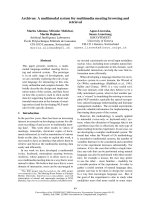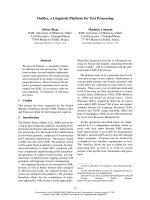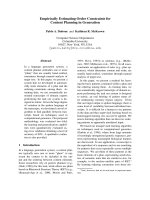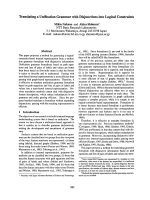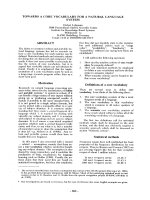Báo cáo khoa học: "TELEGRAM: A GRAMMAR FORMALISM FOR LANGUAGE PLANNING" pptx
Bạn đang xem bản rút gọn của tài liệu. Xem và tải ngay bản đầy đủ của tài liệu tại đây (437.5 KB, 5 trang )
TELEGRAM:
A GRAMMAR FORMALISM
FOR LANGUAGE PLANNING
Douglas E. Appelt
Artificial Intelligence Center
SRI
International
Menlo Park, California
O. Abstract
Planning provides the basis for a theory of language
generation that considers the communicative goals of the
speaker when producing utterances. One central problem
in designing a system based on such a theory is specifying
the requisite linguistic knowledge in a form that interfaces
well with a planning system and allows for the encoding
of discourse information. The TELEGRAM (TELEological
GRAMmar'} system described in this paper solves this prob-
lem by annotating a unification grammar with assertions
about how grammatical choices are used to achieve various
goals, and by enabling the planner to augment the func-
tional description of an utterance as it is being unified.
The control structures of the planner and the grammar
unifier are then merged in a manner that makes it possible
for general planning to be guided by unification of a par-
ticular functional description.
1. Introduction
By viewing language generation as a planning process,
one can not only account for the way people use language
to satisfy different goals they have in mind, but also model
the broad interaction between a speaker's physical and
linguistic actions. Formal models of planing can provide
the basis for a theory of language generation in which
communicative goals play a central role. Recent research
in natural-language generation [1][2] has established the
feasibility of regarding planning as the basis for the genera-
tion of utterances. This paper examines some of the prob-
lems involved in devising a grammar formalism for such a
generation system that produces utterances and describes
a particular implementation of a unification grammar, re-
ferred to as TELEGRAM, that solves some of these prob-
lems.
The KAMP
system [1] was designed with the problems
of multiple-goal satisfaction and the integration of physi-
cal and linguistic ~etions in mind. KAMP is a multiagent
planning system that can be given a high-level description
This research was supported by the National Science Foundation
under Grant MCS-8115105. The author
is
grateful to Barbara Grosz
for helpful comments on earlier d~'afts of this paper.
of an agent's goals, and then produce a plan that includes
the performance of both physical and linguistic actions
by several agents that will achieve the agent's goals. In
the development of KAMP it was recognized that syntactic,
semanlic and pragmatic knowledge sources are necessary
for the planning of utterances. These sources of knowledge
were stored independently inside the system: a grammar
was provided in addition to the axioms that constitute
the agent's knowledge of the pragxnatics of communica-
tion. However, rather than have one process that decides
what to say, drawing on knowledge about the world and
about communication, plus another independant process
that decides how to encode that knowledge into English,
KA,XlP employs a single process that uses both sources of
knowledge to produce plans.
The primary focus of the research on KAMP was the
representation and integration of the knowledge needed
to make plans involving utterances. One area that
was neglected was the representation of grammatical
knowledge. KAMP relies on a very simple grammar com-
posed of context-free rules that enable it to generate simple
sentences. Such phenomena as gapping are totally outside
of its capSbility. Because of the ad hoc nature of the rep-
resentation, modifications and extensions of its linguistic
coverage are very difficult.
Another criticism of KAMP's approach was that there
was no obvious way to control the planning process.
Instead of formulaLing a plan quickly. KAMP would search
a large space of linguistic alternatives until it found an
"(,primal" solution. As some critics have pointed out, (e.g.,
[51) such exhaustive planning is often not needed in prac-
tical ~ituations and is certainly not how people produce
utterances in real time. KAMP would never produce an
ungrammatical sentence, because it could always do un-
limited backtracking after making an incorrect decision.
"Flit' remainder of this paper describes how to use a
unification grammar*
to address these two problems of
r,,pr4.s~,ntation and control.
2.
Unification Grammar
A unification grammar characterizes linguistic entities
* (.lnific~tion gramma.r has often been referred to as
Junctional gram-
mar in the fiterature, e.g., [7], Jill. It is related to and shares many
ideas with systemic grammar [6].
74
by collections of features called a
functional description
(FDs).
Each of the features in an FD has a value that
can be either atomic or another functional description. A
unification grammar is a large FD that characterizes the
features of every possible sentence in the language. In this
paper, the FD that characterizes the intended utterance is
called the
teat FD
and the FD that constitutes the gram-
mar is called the
grammar FD.
The most salient feature of unification grammar that
distinguishes it from other grammatical formalisms is its
emphasis on linguistic
function.
All of the features used
by the grammar have equal status, with functional
and
discourse-related features like
topic
and
focus
sharing equal
status with grammatical roles like
subject
and
predicate,
and with syntactic categories like
NP
and
VP.
Unification grammars are particularly well suited for
language generation because they allow the encoding of
discourse features in the grammar. A functional descrip-
tion can be constructed incorporating these features, and
the syntactic details of the final utterance can then be
specified through unification with the grammar FD. The
process that constructs the text FD can treat it as a high-
level blueprint fleshed out by unification, thereby reliev-
ing the high-level process of the need to consider low-level
grammatical details. This strategy was used by McKeown
{111.
Two functional descriptions can be
unified
by an algo-
rithm that is similar to set union. Suppose FI and F2 are
functional descriptions. To compute the unification, Fa, of
F, and Fz, written F3 = FI ~ Fz, the following algorithm
is used:
If (A,v,) is a feature-value pair, and ()'l,v,) E Fl
and
Vz (fl, z) ~
Fz, or (f,, vl) E F2 and
Vx(ft, z)
¢~ Ft,
then
(:,,
v,
) ~
&.
If (fl,
v,) E
F, and (fl, vz) E Fz, then (fl, va) E/'3, where
the following conditions apply:
If v, -~ NIL then v3 = vz, and similarly for vz.
If vl = ANY and v2 ~ NONE, then t,a = vz,
and-similarly for vz.
If v, ~ v~, then v3 = vl.
If v, and v2 are functional descriptions, then v3
7)I ~ U2.
If any one of the above conditions fails, then the unification
itself fails and the value of F1 ~ F2 is undefined.
Functional descriptions can optionally contain a distin-
guished feature called
PATTERN
that is used to specify the
surface order of constituents in the FD. The unification
of two patterns is different in that it is based on deciding
whether or not the orderings represented by the two pat-
terns are consistent.
In spite of its advantages, there are some serious prob-
lems with unification grammar if it is employed straightfor-
wardly in a language planning system. One of the most
serious problems is the inefficiency of the unificat;,,- -!go-
rithm as described above. A straightforward application
of that algorithm is very expensive, consuming an order-
of-magnitude more time in the unification process than in
the entire planning process leading up to the construction
of the text FD [11]. The problem is not simply one of
efficiency, of implementation. It is inherent in any algo-
rithm that searches alternatives blindly and thereby does
work that is exponentially related to the number of alter-
natives in the grammar. Any solution to the problem must
be a conceptual one that minimizes the number of alter-
natives that ever have to be considered.
Another problem is that the text FD is not as high-level
a blueprint as is really needed because every feature related
to the speaker's intention to communicate must be part of
the text FD when unification takes place. This implies,
for example, that every descriptor that is part of a refer-
ring expression must be specified in advance. This may
be unnecessary because for certain grammatical choices,
the referring expression may be eliminated entirely. For
example, in the by-phrase in a passive sentence, reference
may be made pronominally {or not at all), in which case
descriptors are unnecessary. Since the planner must know
the linguistic context when planning descriptors, a noun-
phrase FD is best constructed initially with a REFERENT
feature, and later expanded by adding features that cor-
respond to the descriptors.
While it is conceivable that the grammar could be
designed to expand a REFERENT feature into a set of
descriptors, that would amount to encoding in the gram-
mar what is essentially a planning problem. This is un-
desirable because the grammar, being a repository of syn-
tactic knowledge, should be separated from pragmatic
knowledge. Conversely, it is also desireable to separate
detailed syntactic knowledge from the planner, and the
failure to do so was a major shortcoming with KAMP.
The next section describes how unification and plan-
ning can be combined to allow syntactic knowledge to be
separated from the planner, but still allow the required
flexibility of interaction between the planner and the gram-
mar.
3. Combination of Unification and Planning
The TELEGRAM system solves the problems of
efficiency and modularity through a close coupling be-
tween the processes of unification and planning. (The
name TELEGRAM stands for TELEological GRAMmar be-
cause planning and goal satisfaction are integreated into
the unification process.)
K.AMP divided its actions into an abstraction hierarchy.
The action hierarchy, as it pertains to linguistic actions,
75
|
IIIocutionary
Acts
u• i
II
I
Surface Speech Acts
Ask
III
Concept Activation
PropodUo~ Acts
Utterance
Acts ]
Figure
3,1
KAMP's Hierarchy of Linguistic Actions
is shown in Figure 3.1. Actions called illocutionary acts
are at the top of the hierarchy, with surface speech acts
and concept activation actions falling below, while the
ac-
tual
performance of the utterance is at the lowest level.
lllocutionary acts are easily described at an abstract level
that. is best reasoned about by a conventional planning sys-
tem, as was done in
K.AMP [|1
and by Cohen [2 I. However,
as one progresses down the hierarchy, the planning be-
comes more and more dependent on the constraints of the
grammar, although goal satisfaction is still very much a
part of the reasoning that takes place. It is at the level
of surface speech act and concept activation actions that
the planning and unification processes can be most advan-
tageously merged.
The means of combining planning and unification
works as follows. At the time the planner plans to per-
form a surface speech act, enough information has been
specified so that it knows the general syntactic structure
of the sentence (declarative, interrogative, or imperative}.
A functional description of the utterance is created and
then ~mified with the grammar.
This functional description is very general and does
not contain suMcient information to specify a unique sen-
tence. The functional description is elaborated
during the
process of unification
so that it adds features incrementally
to the functional description. The planner is called upon
by the unification algorithm at the appropriate time to add
the appropriate features. The end result is a functional
description that is the same as if a complete functional
description of the intended utterance had been unified with
the grammar by means of a conventional unification algo-
rithm that does not invoke planning.
The planner is invoked by the unifier when either of
two situations arises:
The unifier detects a feature in the text FD that
has no corresponding feature in the grammar
FD. Such features are a signal that elaboration
must be performed. The feature is annotated
with a goal wff that the planner plans to achieve,
and the resulting actions specify additions to the
functional description being unified. The unifi-
cation process then continues in the normal man-
ner.
¢ The unifier detects a choice in the grammar
functional description that cannot be resolved
through the unification of atomic features. Each
choice in the grammar is annotated with a wff
that describes to the planner what the effects
of making the choice will be. The planner
then decides which alternative is most consis-
tent with its plans, making an arbitrary choice
if insufficient information is available for a deci-
sion.
The combination of planning and unification that
results has a number of benefits resulting from annotating
a grammar with information useful to the planner, rather
than trying to work linguistic knowledge into the planner
in an ad hoc manner.
The ability to perform action subsumption, the op-
portunistic "piggybacking" of related goal~ as described
in Ill, is enhanced. Whether or not one can incorporate
additional nonreferring descriptors into a noun phrase
is governed by the structure and function of the noun
phrase being planned. For example, a pronominal refer-
ence cannot incorporate any additional descriptors at all.
Therefore, if a planner were to decide whether or not to
perform action subsumption, it would have to know in ad-
vance how a referent was going to be realized. If this were
to be performed before unification, the planner would have
to have the detailed lin~-uistic knowledge to know that it
was possible. With a simple grammar like KAMP'S this
was possible, but with a larger grammar it is clearly un-
desirable.
The ability to do multiple-utterance and discourse
planning is also enhanced. Since the grammar and plan-
ner are closely coupled, information can be easily fed back
from the ~rammar to the planner. This feedback is one of
the features that distinguish a language planning system
from a system that first decides what to say, then how
to say it. When an alternative is chosen, the planner has
information about the goal that is to be achieved through
the selection of that alternative. If unification based on
that selection fails, the planner, instead of blindly trying
other alternatives, can revise the entire plan including
76
the incorporation of multiple utterances where only one
was planned originally.
4. Example.
This
example illustrates
how
a language system can use
an annotated unification gramar like TELEGRAM. Suppose
that there are two agents operating in an equipment as-
sembly domain, and that the planning agent decides that
the other agent should know
that the
location of a screw-
driver S I is in a particular toolbox,
TB1.
He then plans
the illocutionary
act*"
Do(AGT1, Inform(AGT2, Location(S1) = TB1)).
The planner then plans a surface speech act consist-
ing of a declarative sentence with the same propositional
content as the illocutionary act. However, instead of con-
structing a syntactic-structure tree by using context-free
rules, as in K.AMP would do in this example, the TELEGRAM
planner will create a high-level functional description of
the intended utterance. For this example, the functional
description would look like the following.""
"CAT S
[CAT = NP ]
SUBJ = [REFERENT = S1
[CAT = V ]
VERB = [LEX BE
= [PREP = [LEX = IN]
p CAT ~ NP
C, OMP
[ OBJ=[REFERENT=TB1
At this point., the planner is no longer directly in control
of the planning process. The planner invokes the unifier
with the above text functional description and the gram-
mar fimctional description, and relinquishes control to the
unifical ion process.
The unification process follows the algorithm described
in Section 2, until there is either an alternative in the
grammar that needs to be selected or some feature in the
text FD does not unify with any feature in the grammar
FD.
In this example, the second of these situations arises
when the noun phrase FD
CAT=NP TBI]
REFERENT =
** The precise meanings the elements of this representation are
described in [1], but their intuitive meaning-J are adequate for under-
standing this paper.
*** Using the notation of Kay 17][8].
is unified with the functional description of a noun phrase
from the grammar:
CAT NP ]
PATTERN (DET MODS HEAD QUAL)
DET- [ ,]
HEAD = [CAT = N]
MODS -~ [ 1
qUAL = [ 1
The FD for the noun phrase tells what the structure of
the constituent is, but it does not contain a REFERENT
feature. The straightforward application of the unification
algorithm of Section 2 would simply yield the grammar FD
along with the feature "REFERENT ~ TBI," which is
not particularly useful. However, the feature REFERENT
has an annotation that tells the unifier that the planner
should be invoked with the goal of activating the concept
TBI for AGT2. The planner then plans a concept activa-
tion action, using its knowledge about AGTI and AGT2's
mutual knowledge, perhaps inserts a pointing action into
the plan, and augments the text FD to resemble the fol-
lowing:
CAT = NP 1
DESC = (Toolbox(TBl), Under(TBl,
TABLEU)J
The new augmented functional description still does
not unify with the grammar FD, but the annotation for
the DESC feature is written to insert FDs corresponding
to each of the descriptors into the text FD. This next
expansion results in the following FD:
"CAT = NP
fNB = J
DET = [SUBCAT = DEF
HEAD = [LEX = TOOLBO:q
PREP = [LEX ~ UNDER]
QUAL
[CAT NP
POBJ [REFERENT = TABLE1
This FD can be unified directly with the grammar FD,
using the algorithm described in section 2. It is identical
to the one that would have been planned had the entire
FD been specified at the start of the unification process.
However, by postponing some of the planning, and plac-
ing it under control of the unification process, the system
preserves the ability to plan hierarchically while enhancing
its ability to coordinate physical and linguistic actions.
5. Comparison with Related Systems.
There are several significant differences between TELE-
GRAM and other natural-language-generation systems that
77
have been developed using unification grammar or systemic
grammar.
The TEXT system developed by McKeown [11] uses a
unification grammar to generate coherent multisentential
text and employs a straightforward unification algorithm.
The unifier does not draw upon the system's pragmatic
knowledge to decide among alternatives in the grammar,
and being reduced to blind search, it requires a great deal
of time to unify a single text functional description. The
TEXT system does all its planning during the construction
of the text FD and uses the unification process to fill in
the grammatical details essential for producing the final
utterance.
The NIGEL grammar designed by Mann [10] is a sys-
temic grammar, but the. philosophies underlying systemic
and unification grammar are so similar that a comparison
of the systems is warranted. The system "choosers" of
NIGEL play a role similar to the annotations on the al-
ternatives in TELEGRAM, and many other parallels can
be drawn. The most fundamental difference between the
two systems is in the assmptions underlying their design.
NIGEL is intended to be completely independent of any
particular application system or knowledge representation,
an intention that has influenced all aspects of its design.
A consequence of this decision is a complete separation of
the grammatical processes from the other processes in the
system, permitting communication only through a narrow
channel. TELEGRAM, on the other hand closely couples
reasoning about syntactic choices with the other planning
done by the system, thereby enabling the reasoning about
combined physical and linguistic actions. However, TEL-
EGRAM sacrifices some of the simplicity of the interface
between the grammar and the rest of the system.
6.
Summary
and
Conclusion.
The TELEGRAM system described
in
this paper is
an
at, lempt to incorporate a large grammar into a language-
planning system. This particular approach to representing
knowledge in an annotated unification grammar and com-
bining the processes of planning and unification results in
the following advantages:
• Greater efficiency in the lower levels of the plan-
ning process, because the planner can be invoked
to decide among alternatives, thus avoiding the
reliance upon blind search.
• A simple method of resource allocation to the
planning process by limiting the amount of back-
tracking the unifier is allowed to do.
• The ability to combine reasoning about physi-
cal and linguistic actions with a grammar that
provides significantly wide coverage of the lan-
guage.
Although the development of TELEGRAM is still in
progress, early experience suggests that the TELEGRAM
formalism has sufficient power to represent the syntactic
knowledge of a language-planning system that efficiently
encompasses a significant portion of English. A small
grammar has been written that already has more power
than the grammar of KAMP. Research is being conducted
in discovering those discourse-related features that have to
be included in a unification grammar. Although writing a
~reversible ~ grammar does not appear to be feasible at this
time, we hope this research will lead to the specification
of a set of features that can be shared between unification
grammars for parsing and for generation.
[11
{21
131
141
{01
[71
tsl
REFERENCES
[01
[1ol
Illl
Appelt, Douglas E.,
Planning Natural Language Utter-
ances to Satisfy Multiple Goals,
SRI International Arti-
ficial Intelligence Center Technical Note No. 259, 1982.
Cohen, Philip and C. R. Perrault,
Elements of a Plan-
Based Theory of Speech Acts,
Cognitive Science, vol.
3, pp. 177-212, 1979.
Cohen, Philip,
The Need for Mentificaion as a Planned
Action,
Proceedings of the Seventh International Joint
Conference on Artificial Intelligence, 1981.
Cohen, Philip, S. Fertig and K. Start,
Dependencies
of Discourse Slructure on the Modalily of Commun-
ication: Telephone vs. Teletype,
Proceedings of the
Twentieth Annual Meeting of the Association for Com-
putational Linguistics, 1982.
Conklin, E. deffery, and D. McDonald,
Salience: The
Key to the Selection Prob&m in Natural Language Gen-
eration.
Proceedings of the Twentieth Annual Meeting
of the .Association for Computational Linguistics, 1982.
Italliday,
M. A. K., System
and Function in
Lan-
guage,
Oxford University Press, London, 1976
Kay, Martin,
Functional Grammar,
Proceedings of the
Annual Meeting of the Linguistic Society of .America,
1979.
Kay. Martin,
Unification Grammar,
Xerox P.~RC tech
report
Kay, M.~rtin,
An Algorithm for Compiling Parsing Tables
from a Grammar
Mann, William C., and Christian Matthiessen,
Nigel:
A Systemic Grammar for Text Generation,
University
of Southern California Information Sciences Institute
Technical Report ISI/RR-83-105, February, 1983.
McKeown, Kathleen,
Generatin 9 Natural Language Text
in Response to Questions about Database Structure,
Ph.D. dissertation, University of Pennsylvania, 1982.
78





